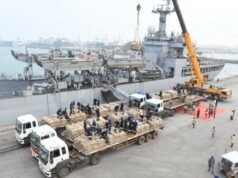This year, Vijay Diwas promises to be different.
As we prepare to mark the 52nd anniversary of the 1971 India-Pakistan war, which led to the birth of Bangladesh on December 16, the irony is difficult to miss.
The war was preceded by a genocidal attack on the Bengali population in East Pakistan.by the Pakistani army.
The soldiers shipped in from West Pakistan were assisted by the local pro-Pakistani Razakars, (traitors) who joined the military’s merry dance of death, pillage and destruction. Students, teachers, women, children were all fair targets.
Their crime: Protesting against the Punjabi-dominated West wing’s attempt to deny the premiership of Pakistan to Sheikh Mujibur Rahman of the Awami League, who had won the election of December 1970, and also against the plan to impose Urdu as the official language in the east. .
By extremely conservative estimates, at least 3 lakh Bengalis were butchered by the West Pakistan army. Some other estimates multiply that number by 10.
Millions of Bengalis from East Pakistan arrived in India to escape the slaughter. India under then Prime Minister Indira Gandhi decided to help recruit, train, and arm some of these refugees, which included defectors from the Pakistani military forces who had pledged loyalty to Mujib. They were called the Mukti Bahini.
The War For Freedom
India formally declared war on December 3, 1971, after fighter jets from West Pakistan crossed the border to strike at Indian airbases and radar installations. While West Pakistan was blockaded by the Indian Navy and Air Force, the Indian Army and Mukti Bahini entered Bangladesh.
Less than a fortnight later, on December 16, 1971, the Pakistani Army led by Lieutenant General Amir Abdullah Khan Niazi, (and the Razakars) that had so bravely slaughtered millions of their own citizens in the East, surrendered meekly to the Indian forces, in what is described as the largest public surrender since World War II.
Like any professional army, the Indian Army withdrew once the job was done, leaving Bangladeshis to run the country.
The Aftermath
It’s been more than half a century since then, but there are still people, both in India and in Bangladesh who remember the horrors and heroism of the time.
But it seems that the current dispensation in Dhaka does not. Because the Md Yunus-led interim administration is clearly keen to kiss and make up with Pakistan.
No doubt, Dr Yunus or whoever else is running the country is free to woo whoever he wants. But I do wonder what all those Bangladeshis who gave their lives to gain freedom from Pakistan might be thinking if they had been alive now. Ditto the thousands of innocent women and children, students and teachers who were slaughtered indiscriminately by what was then their very own army.
Or the 3,843 Indian soldiers that died, and the 9,851 that were wounded while helping the Mukti Bahini liberate Bangladesh.
Were they all wrong? Did they all die in vain?
A General’s View
Was the late Lt General M.L Thapan, a World War II veteran who was tasked with clearing one of the three sectors into which East Pakistan had been divided by India’s Eastern Command in 1971, right after all?
Described as a ‘Thinking Man’s General’ by his peers and subordinates, General Thapan was firmly convinced that India has “no business” helping Bangladesh gain freedom.
“When the country was divided in 1947, the people of East Bengal decided to opt for East Pakistan. That was a decision taken by them, and 25 years later, they found that the authorities in West Pakistan were not favourably disposed towards the east,” he explained in an interview in early 2007. He was 89 at the time, but his eyes still sparkled and his back was ramrod straight.
“Anyway, they had of their own accord joined the western part of Pakistan. So I saw no reason why we should have interfered in their problems. They brought it upon themselves,” he said.
“To put it crudely, they should have stewed in their own juice… Subsequently, the events after the liberation, and after the death of Mujib (Bangladesh’s first president Mujibur Rehman), particularly, have reinforced these views.”
The other aspect, he said, “is that if we had left things alone, today Pakistan would again have been divided into two parts with India in between. That would have been a great administrative problem for them. For us it would have been a great advantage to have the Pakistani armed forces divided between the two halves, which strategically would result in their having to look after two fronts.
Back To The Future
“The present situation in Bangladesh now (the Bangladesh Nationalist Party led by the virulently anti-India Khaleda Zia and supported by a bunch of Islamist parties, had handed over power to an interim government a couple of months earlier, but the elections were held more than year later in December 2008) is obviously unfavourable to us. It is still the same. So we have gained nothing in the bargain,” he argued.
“The ostensible reason given was that there were a large number of refugees had come into India from Bangladesh. Now whether that is sufficient justification to go to war I don’t know. Because today there are more illegal immigrants from Bangladesh than there were at that point of time,” he noted.
Besides, “ You can’t go in to defend or to liberate somebody who is another country just because he or she is being ill-treated. It was their problem, not ours. We’ve got enough problems of our own. What about the humanitarian problems in our own country? Who the hell bothers about those?” he wondered. “There are a large number of Indians now living in the UK. If they are ill-treated, are we going to go into the UK?
“As for the anti-Indian feeling, that is being whipped up by all the fundamentalists in Bangladesh, who were there at that time too but stayed subdued. Of course, they are now being egged on by the ISI in Pakistan,” he said.
Words that could just as easily apply to the current situation.
As we prepare to mark the 52nd anniversary of the liberation of Bangladesh, perhaps a little ruthless introspection might be in order.
Both in Dhaka and in New Delhi.
In a career spanning three decades and counting, Ramananda (Ram to his friends) has been the foreign editor of The Telegraph, Outlook Magazine and the New Indian Express. He helped set up rediff.com’s editorial operations in San Jose and New York, helmed sify.com, and was the founder editor of India.com.
His work has featured in national and international publications like the Al Jazeera Centre for Studies, Global Times and Ashahi Shimbun. But his one constant over all these years, he says, has been the attempt to understand rising India’s place in the world.
He can rustle up a mean salad, his oil-less pepper chicken is to die for, and all it takes is some beer and rhythm and blues to rock his soul.
Talk to him about foreign and strategic affairs, media, South Asia, China, and of course India.





